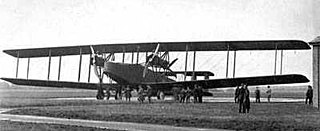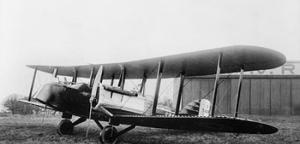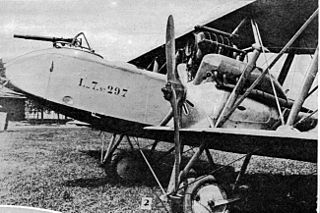
A bomber is a military combat aircraft designed to attack ground and naval targets by dropping air-to-ground weaponry, launching torpedoes, or deploying air-launched cruise missiles. The first use of bombs dropped from an aircraft occurred in the Italo-Turkish War, with the first major deployments coming in the First World War and Second World War by all major airforces causing devastating damage to cities, towns, and rural areas. The first purpose built bombers were the Italian Caproni Ca 30 and British Bristol T.B.8, both of 1913. Some bombers were decorated with nose art or victory markings.

A biplane is a fixed-wing aircraft with two main wings stacked one above the other. The first powered, controlled aeroplane to fly, the Wright Flyer, used a biplane wing arrangement, as did many aircraft in the early years of aviation. While a biplane wing structure has a structural advantage over a monoplane, it produces more drag than a monoplane wing. Improved structural techniques, better materials and higher speeds made the biplane configuration obsolete for most purposes by the late 1930s.

A light bomber is a relatively small and fast type of military bomber aircraft that was primarily employed before the 1950s. Such aircraft would typically not carry more than one ton of ordnance.

Handley Page Limited was a British aerospace manufacturer. Founded by Frederick Handley Page in 1909, it was the United Kingdom's first publicly traded aircraft manufacturing company. It went into voluntary liquidation and ceased to exist in 1970. The company, based at Radlett Aerodrome in Hertfordshire, was noted for its pioneering role in aviation history and for producing heavy bombers and large airliners.
Arado Flugzeugwerke was a German aircraft manufacturer, originally established as the Warnemünde factory of the Flugzeugbau Friedrichshafen firm, that produced land-based military aircraft and seaplanes during the First and Second World Wars.

The Armstrong Whitworth A.W.38 Whitley was a British medium bomber aircraft of the 1930s. It was one of three twin-engined, front line medium bomber types that were in service with the Royal Air Force (RAF) at the outbreak of the Second World War. Alongside the Vickers Wellington and the Handley Page Hampden, the Whitley was developed during the mid-1930s according to Air Ministry Specification B.3/34, which it was subsequently selected to meet. In 1937, the Whitley formally entered into RAF squadron service; it was the first of the three medium bombers to be introduced.

The Handley Page V/1500 was a British night-flying heavy bomber built by Handley Page towards the end of the First World War. It was a large four-engined biplane, which resembled a larger version of Handley Page's earlier O/100 and O/400 bombers, intended to bomb Berlin from East Anglian airfields. The end of the war stopped the V/1500 being used against Germany, but a single aircraft was used to carry out the first flight from England to India, and later carried out a bombing raid on Kabul during the Third Anglo-Afghan War. It was colloquially known within the fledgling Royal Air Force as the "Super Handley". The V/1500 which was shipped to Canada to attempt a transatlantic flight was flown in the US, and in 1919 crash-landed in a field at Mount Jewett, Pennsylvania. Photos appeared in the 20 February 1969 issue of the Bradford Journal newspaper.
The Société des Ateliers d'Aviation Louis Bréguet also known as Bréguet Aviation was a French aircraft manufacturer.

The Albatros G.II,, was a twin-engined German biplane bomber of World War I.

The Gotha Go 145 was a German World War II-era biplane of wood and fabric construction used by Luftwaffe training units. Although obsolete by the start of World War II, the Go 145 remained in operational service until the end of the War in Europe as a night harassment bomber.

The Bréguet Bre.V B.2 bomber and Bréguet Bre.V Ca.2 escort fighter were French biplanes of World War I which were developments of the Bréguet Bre.IV bomber. The Bre.VI and Bre.XII were, in turn, developments of the Bre.V

The Breguet 16 was a bomber biplane produced in France toward the end of World War I.
Number 58 Squadron was a squadron of the Royal Air Force.

The Avro 533 Manchester was a First World War-era twin-engine biplane photo-reconnaissance and bomber aircraft designed and manufactured by Avro.
The Beardmore W.B.1 was a British single-engine bomber biplane of World War I developed by Beardmore.

The Letord Let.5 was probably the most numerous of a family of 3-seat reconnaissance bombers, designed and built in France from 1916, originally to an A3 specification from the STAé.
No. 114 Squadron was a squadron of the British Royal Air Force. It was first formed in India during the First World War, serving as a light bomber squadron during the Second World War and as a transport squadron post-war. It was last disbanded in 1971.

The LFG Roland G.I was a large prototype single-engine biplane bomber built in Germany in 1915, during World War I. It had a single engine buried in the fuselage driving pusher configuration propellers mounted on outriggers.

Société d'Aviation Letord was a French aircraft manufacturing company that was formed in the early 1910s by the French aviation industrialist Émile-Louis Letord. It manufactured a number of military aircraft during the First World War.














